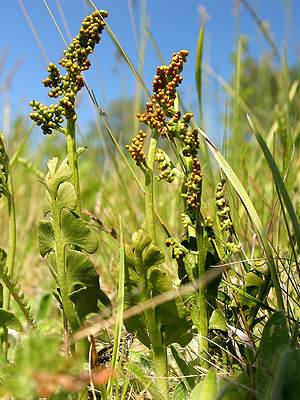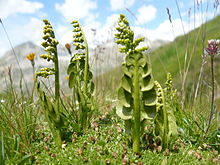Real moon diamond
| Real moon diamond | ||||||||||||
|---|---|---|---|---|---|---|---|---|---|---|---|---|

Real moon diamonds on a lawn in the Lüneburg Heath . |
||||||||||||
| Systematics | ||||||||||||
|
||||||||||||
| Scientific name | ||||||||||||
| Botrychium lunaria | ||||||||||||
| ( L. ) Sw. |
The real moon rue ( Botrychium lunaria ) is an inconspicuous perennial species of the diamond fern . It got its name because of its moon-shaped leaf plumage, which according to medieval beliefs should glow in the moonlight. The scientific genus name Botrychium goes back to the Greek botrychion and refers to the panicle-like arranged sporangia . The specific epithet lunaria means moon according to the German name.
description
The real moon diamond grows up to 30 cm. The frond consists of a sterile section and a section bearing sporangia. At first glance, the fresh green, sterile leaf section hardly looks like a fern leaf and is only visible for a few weeks a year. It appears to arise in the middle of the plant and is significantly longer than wide and not hairy. The blade of the sterile leaf section is pinnate with two to nine wedge-shaped or moon-shaped sections. These have given the moon diamond to its name. The sporangia are on the panicle-like branched fertile leaf section. They form a multi-layered wall and contain spores of the same shape.
The species chromosome number is 2n = 90.
ecology
The spores germinate in the soil in the dark. Then the pre-germ emerges, which also always occurs underground. The young plant arises from it. Both live parasitically and feed on products of specially adapted root fungi. Such a way of life is called mycoheterotrophy. The above-ground adult plant forms panicle-shaped arranged sporangia on a shoot, which form spores.
However, the moon rue can also reproduce vegetatively. This usually takes place via endogenous secondary shoots formed from the roots.
The real moon rue also forms the disaccharide trehalose, which is rarely found in plants, as a reserve substance .

Occurrence and protection
The moon rue occurs in Europe, Asia and North America from the lowlands to the montane regions of the mountains. The fern plant, which is rare in Central Europe, often grows on rocky grasslands, sandy heaths, on embankments or rarely on sandy roadsides. It is a weak Nardetalia order character, but also occurs in societies of the Sedo-Scleranthetea class or the Mesobromion association.
In Germany the moon rue is only rarely found. In some federal states it is even very rare, which is why the fern plant has been specially protected by the BArtSchV . It is also on the Red List of Threatened Plant Species in Germany because its populations are currently in decline. This is mostly due to the increasing eutrophication of the soil due to fertilizer input or immissions. Other causes are the destruction of small-scale special locations and the abandonment of heath use by humans.
In the Allgäu Alps, it rises at the summit of the Linkerskopf in Bavaria up to 2455 m above sea level.
Taxonomy
The Basionym Osmunda lunaria was first published in 1753 by Carl von Linné in Species Plantarum . Olof Peter Swartz placed it in 1801 as Botrychium lunaria in the genus Botrychium .
Common names
For the Echte Mondraute there are or existed, in some cases only regionally, the other German-language trivial names : Allermannsherrnkraut ( Harz ), Ankerkraut ( Linz ), Ankehrkraut ( Austria ), Bseichkraut ( Zillertal , Salzburg ), Eisenbrech (Austria), Erdstern, Gebirgsmon, birth herb, Geisstödi ( Graubünden near Vocks.), Whore grass ( Tyrol ), whore herb (Tyrol near Lienz ), whoreweed, orchid, liverwort, cornwort ( Württemberg , Franconia , Henneberg), corn herbs ( Niederhessen ), corn grapes (mentioned as early as 1661) , Mitzunglein, Mondkraut, Monrauten, St. Peterskey (Tyrol im Pongau and Pinzgau ), Rindskraut, Traut Babbichen look at me ( East Prussia ), Treublätter ( Frankfurt (Oder) , mentioned as early as 1681), St. Walpurgiskraut ( Swabia , Entlibuch ) and Weißer or Rechter Widerthon ( Silesia ).
swell
literature
- Eckehart J. Jäger, Klaus Werner (Ed.): Excursion flora from Germany . Founded by Werner Rothmaler. 10th edited edition. tape 4 : Vascular Plants: Critical Volume . Elsevier, Spektrum Akademischer Verlag, Munich / Heidelberg 2005, ISBN 3-8274-1496-2 .
- Ruprecht Düll , Herfried Kutzelnigg : Pocket dictionary of plants in Germany. A botanical-ecological excursion companion to the most important species . 6th, completely revised edition. Quelle & Meyer, Wiebelsheim 2005, ISBN 3-494-01397-7 .
Individual evidence
- ↑ a b Erich Oberdorfer : Plant-sociological excursion flora for Germany and neighboring areas . 8th edition. Stuttgart, Verlag Eugen Ulmer, 2001. Page 70. ISBN 3-8001-3131-5
- ↑ Erhard Dörr, Wolfgang Lippert : Flora of the Allgäu and its surroundings. Volume 1, IHW, Eching 2001, ISBN 3-930167-50-6 , p. 64.
- ↑ Carl von Linné: Species Plantarum. Volume 2, Lars Salvius, Stockholm 1753, p. 1064 ( digitized version ).
- ↑ Olof Peter Swartz: Genera et Species Filicum ordine systematico redactarum. In: Journal for botany (Ed. Heinrich Adolf Schrader ). Year 1800, No. 2, 1801, pp. 1–121, here: p. 110 (online) .
- ^ Georg August Pritzel , Carl Jessen : The German folk names of plants. New contribution to the German linguistic treasure. Philipp Cohen, Hannover 1882, p. 61, online.
Web links
- Botrychium lunaria. In: FloraWeb.de.
- Real moon diamond . In: BiolFlor, the database of biological-ecological characteristics of the flora of Germany.
- Profile and distribution map for Bavaria . In: Botanical Information Hub of Bavaria .
- Distribution in the Netherlands [1] (Dutch)
- Botrychium lunaria (L.) Sw. In: Info Flora , the national data and information center for Swiss flora .
- Distribution in the northern hemisphere from: Eric Hultén, Magnus Fries: Atlas of North European vascular plants. 1986, ISBN 3-87429-263-0 at Den virtuella floran (swed.)
- Thomas Meyer: Mondraute data sheet with identification key and photos at Flora-de: Flora von Deutschland (old name of the website: Flowers in Swabia )
